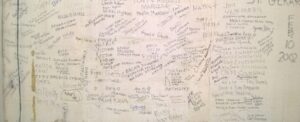St Gerard History Book from 1946-1974 
In 1946, Roanoke’s Black Catholics were subject to segregation, even at Mass. Bishop Peter Ireton engaged the missionary Redemptorist Order to investigate the possibility of serving these Catholics and evangelizing in the Black community. That September he appointed Fr. Maurice McDonald to establish a mission parish for the benefit of African-Americans in Roanoke.
Fr. McDonald soon found a house that could be renovated for a chapel and rectory. On October 16, the Feast of St. Gerard, he received permission to purchase it. Ever since, the first and only Black Catholic parish in Southwest Virginia has been known as St. Gerard Catholic Church. The following year, the Redemptorists opened another parish in Salem called Our Lady of Perpetual Help, which operated as a mission of St. Gerard for several years.
The parish of St. Gerard grew quickly, and the present church was constructed at 809 Orange Ave. NW in 1951. A rectory for the Redemptorists was connected at the rear of the building. St. Gerard grew and became a center of activity for the surrounding Black community. But as society changed, Bishop John J. Russell decided that vestiges of discrimination should end. The bishop closed many segregated parishes, but St. Gerard remained open. Thus “reverse integration” began as Whites were welcomed and began to attend and participate at St. Gerard.
In 1974 St. Gerard became a Diocesan parish. Bishop Walter Sullivan appointed Fr. Michael Schmied as pastor, and he began the work of helping the parishioners develop better relationships with the Diocese with an emphasis on sharing our unique cultural, spiritual and racial heritage. In 1977, St. Gerard welcomed Fr. Walter Barrett, the first Black Diocesan pastor in the Diocese of Richmond. An iconic African hand carved “Black Christ” crucifix was hung in the church. The crucifix was updated in 2002, and again in 2017, but the hand-carved figure of Christ remains the same.
In 1996, another group was welcomed when members of the local Hispanic community approached Fr. Wayne Ball about having a Mass in Spanish. That May, he started the area’s only Spanish Mass, and Hispanic attendance took off at a speed that no one anticipated. Within ten years, fifty percent of the parish was Hispanic, and Hispanic parishioners initiated the formation of new ministries, musical and liturgical traditions with a focus on drawing its members closer to the work of the church.
In late 2007, under Fr. Rene Castillo, St. Gerard welcomed more than 20 refugee families from the Democratic Republic of the Congo and Burundi who were resettled in Roanoke. Today, the African parishioners are fully involved in the liturgical ministries as altar servers, lectors, choir, and extraordinary ministers.
In 2017, the worship space was renovated, turning the congregation 90 degrees. The tabernacle was relocated to a place behind the altar, to where it would have been when the church was built in the 1950’s. In 2018, the parish purchased a neighboring property and named it Kibeho House. It became a gathering place for the African community.
St. Gerard now offers regular Masses in Spanish, and African languages and music have been incorporated into the English language Mass each weekend. Holy Day services are conducted in three languages, creating the most diverse and crowded liturgies, as St. Gerard continues to strive to be “a house of prayer for all people.”
